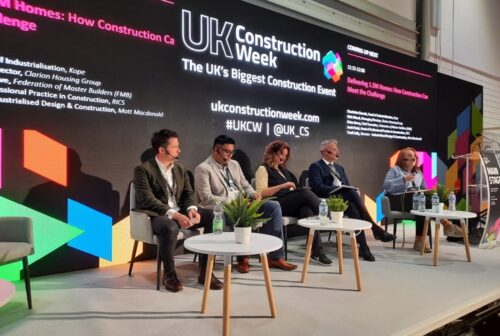Anatomy of a housing crisis

With house prices in London increasing by nearly 500% over the last 30 years, the housing market has become increasingly inaccessible to younger generations. In 1999, the average house price in England was 4.4 times the average household income. By 2023, this ratio had nearly doubled to 8.6 times the average household income, and in London, it’s even worse, with an average-priced home costing the equivalent of 14 years of a median-income household. This has led to a shrinking pool of homeowners and the rise of “Generation Rent.”
1.29 million households are on social housing waiting lists across England and the number of families living in temporary accommodation has surpassed 110,000.
Local authorities are struggling to keep up, with London councils alone spending over £90 million a month on temporary accommodation. The human cost is just as severe. Unstable housing affects educational outcomes, mental and physical health and social mobility.
Some argue it’s not just a housing crisis but an affordability and political legitimacy crisis. With growing dissatisfaction from a generation excluded from homeownership and a multipolar political landscape emerging, the case for bold, innovative housing reform has never been stronger.
Following the UK Construction Week Conference, Laura Di Bello takes a deep dive into some of the contributing factors creating a perfect storm out of the housing crisis.
Contributing factors
1. Planning system overhaul
According to the Home Builders Federation, the average time for a local authority to determine a major planning application is over eight months, far exceeding the statutory 13-week target. Across the UK, this has led to a backlog of over 145,000 homes stuck in the planning system.
A recent CMA report identified “under-resourced planning departments and local plans not up to date” as additional major blockers in planning departments. These delays not only slow down delivery but also erode confidence in the system, deter investment and increase costs; making it harder to deliver affordable housing or test innovative models.
2. Green Belt constraints
The Green Belt, originally created to limit urban sprawl and preserve countryside, now covers around 12.5% of land in England — equivalent to an area one and a half times the size of Yorkshire. The policy is often applied indiscriminately, even to areas that are low-value, poorly maintained or already previously developed on.
London suffers from acute land scarcity, and the inflexibility of the Green Belt contributes to rising inner-city land prices, prompting Sadiq Khan to take a dramatic policy shift to tackle the issue head-on and build on the Green Belt.
3. Unlocking financial investment
Building new homes at scale requires more than land and permission. It also needs capital investment. One of the biggest constraints to delivery is the lack of long-term, blended funding models that can de-risk large or complex schemes.
Public sector-led investment models, like the proposed £2bn City Hall development fund, have the potential to unlock significantly more private capital (a targeted £9 of private funding for every £1 public). These funds could support site acquisition, land remediation, infrastructure improvements and early-stage planning to make developments viable.
4. Land Value Capture (LVC)
The UK’s land market often sees enormous value uplift once planning permission is granted, yet much of this profit flows to landowners rather than the public.
Historically, the New Towns Act (1946) enabled landowners and local authorities to share post-planning value gains, allowing councils to invest in new communities, not just houses. This changed with the Land Compensation Act (1961), which gave landowners and developers full right to land value increases – including speculative ‘hope value’.
A revised land value capture mechanism could channel these gains into infrastructure, schools, transport links, and affordable housing.
For a deeper dive into the topic, see Liam Halligan’s excellent book: “Home Truths – The UK’s chronic housing shortage: how it happened, why it matters and how to solve it.”
5. Market diversification
The UK’s housing market is dominated by a small number of large developers. Smaller developers often struggle to access land, capital, and consistent pipelines of work.
To address this:
- Local authorities could identify and bundle small sites into development-ready packages
- Funding schemes could be tailored for SME builders, reducing upfront risk
- Procurement and planning guidance could prioritise local delivery partners.
A more diverse housing market could speed up delivery, create jobs, and ensure homes are built with local needs and character in mind.
6. Community engagement and trust
Public opposition to development — better known as NIMBYism — frequently stems from poor communication, exclusion from decision-making, or past experiences of overdevelopment without adequate infrastructure.
Developers are often perceived as short-term profiteers. To counter this, we need to embed participatory placemaking and genuine consultation in every project. That means co-designing spaces with residents and ensuring new schemes contribute to the social fabric of places.
True success comes when new homes feel like a natural extension of a community, not an imposition on it.
Closing reflection
The UK’s housing crisis isn’t simply about increasing supply – it’s about building the right type of homes, in the right locations, that genuinely meet the needs of communities.
The sector must shift focus away from purely speculative investment, towards placemaking, long-term social and environmental value, and purpose-driven investment.
The solutions are available: reform planning, release appropriate land, attract long-term investment, diversify delivery models, and embed social value. Yet the path forward demands coordination, courage, and a renewed commitment to making housing a public good.
Are we ready to rethink land policy and political priorities to make this happen?
Can we reimagine the built environment not just as infrastructure, but as the foundation for a more equal and inclusive society?
What kind of housing legacy do we want to leave for future generations?
The answers will shape more than our skylines — they’ll shape the society we become.